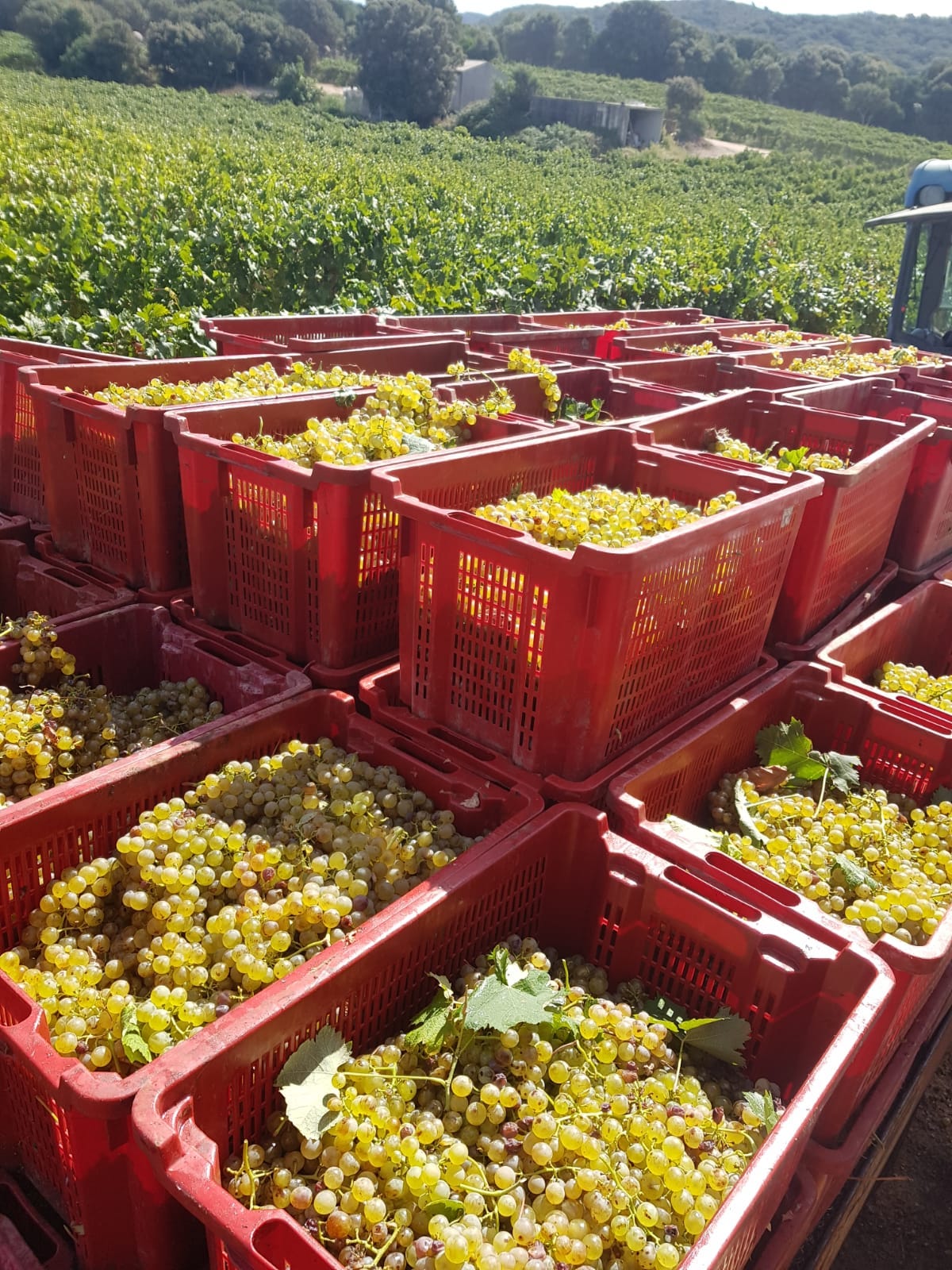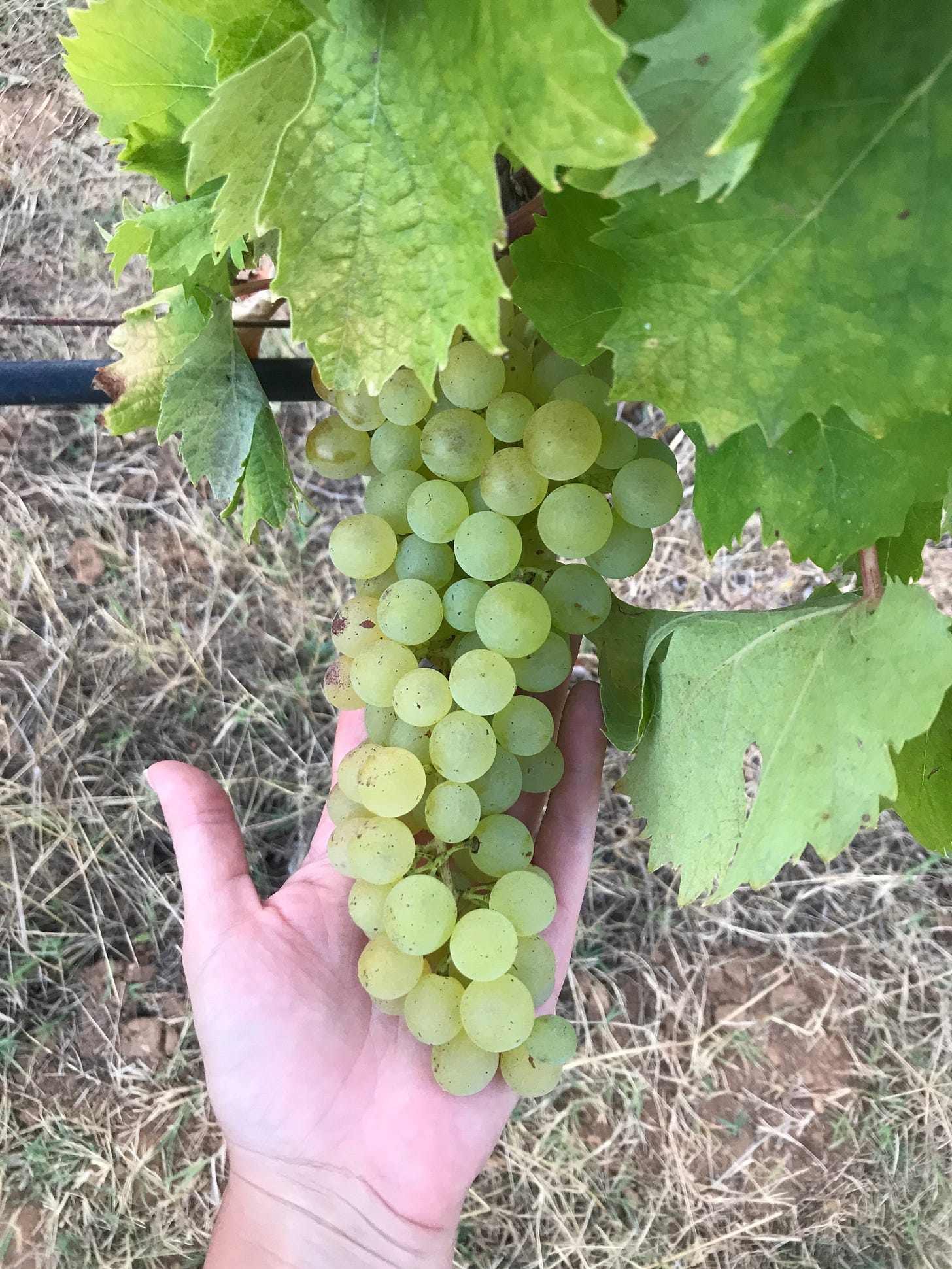Vermentino: The Complete Guide to a Quintessential Sardinian Wine
Uncover the best Sardinian Vermentino producers, top regions, food pairings, and more.
Let’s explore one of Sardinia’s most beloved wines – Vermentino. Since I’ve already covered Cannonau extensively, it’s high time for Sardinian Vermentino to have a moment in the spotlight.
Before my first visit to Sardinia around seven years ago when I arrived to meet my future in-laws for the first time, I had never tried Vermentino. I asked Marco to take me on a personal wine tour to discover the island’s wines, and boy did he deliver! If memory serves, our first winery visit was to Nuraghe Crabioni where we sampled their range of wines and I recall being pleasantly surprised by their mineral-driven Vermentino with a bitter almond finish. I didn’t really speak any Italian yet at that point, and Marco struggled to translate the details our host shared with each pour, followed by all of us bursting with laughter at the confusion that ensued. We were just at the beginning of our relationship with all of the butterflies, excitement, and the kind of love where you just can’t get enough of each other. Now, whenever I encounter a Nuraghe Crabioni wine, I’m instantly transported back to that memory.
Though admittedly, now that I’m more familiar with Sardinian wines and considering how my palate has evolved over the last seven years since entering the wine industry, Nuraghe Crabioni Vermentino would probably not be at the top of my list of recommendations.
Actually, allow me to preface this article with a truthful disclaimer: there is a lot of bad Vermentino being made in Sardinia.
There, I said it and I’m not ashamed that I did because honestly, it’s quite difficult to make a high quality white wine. You’re likely to encounter a lot of Vermentino with residual sugar (often too much) or with additions of tartaric acid in hopes of boosting that mouthwatering acidity after a hot growing season. While the wine might be technically sound, it’s lacking that sense of place, the terroir and expression that only truly great wines can capture. And for me, that’s what wine is all about.
Don’t make a Sardinian Vermentino and then blend in other varieties like Savagnin, Trebbiano, Müller Thurgau, or even Gewürztraminer to boost aromatics, then slap on a Vermentino label and call it a day. Yes, that is actually happening. All too frequently, I might add.
Plus, many Sardinian Vermentino wines that you’ll find in America, for example, are from the larger commercial wineries like Pala, Santa Maria La Palma, Dolia Nova, or Sella e Mosca. At least these are a lot of the commercial wineries I’ve seen on American shelves. There is absolutely nothing wrong with these wines. In fact, some are quite good, but the Vermentino wines you’ll discover in this article are made by passionate, often boutique producers tending to their vineyards and cellars with care (and generally without the fancy schmancy consultants). And you can bet your ass that you’ll taste the difference! So, here we go…
What is Vermentino?
First, before we dive into the best regions and producers for Vermentino let’s discuss the characteristics of this Italian variety so you know what you’re getting yourself into.
Vermentino in the Glass
Vermentino is an ideal wine for lovers of fresh, aromatic or semi-aromatic whites like Sauvignon Blanc, Grüner Veltliner, Chenin Blanc, and Pinot Grigio. If you’ve never had Vermentino from Sardinia before, here’s what you can generally expect:
Aromas & Flavors: Sardinian Vermentino is typically characterized by aromas and flavors of citrus (lime, grapefruit, lemon), pear, melon, herbal undertones like sage, daffodil, or Mediterranean macchia, and salinity or minerality with a trademark bitter almond finish.
Structure: Structure varies depending on site and producer, but Vermentino typically has high acidity and vibrant flavors with medium body and high alcohol.
Alcohol: Sardinian Vermentino can get up to 15% abv in warmer vintages, but most are around 12-13% abv.
Ageability: Vermentino is frequently made in a drink-now style, but exceptional examples, or those that have seen some time in oak, can age well for 3-5 years.
The majority of Sardinian Vermentino is vinified in stainless steel to maintain freshness. However, there are a handful of producers working with oak and amphora to enhance complexity. I’ll cover those below.
Oh, I should also mention that Sardinia isn’t the only place where Vermentino grows. You’ll find this variety on mainland Italy in Liguria where it’s known as Pigato and in Piedmont where it’s called Favorita. It’s also grown in Tuscany and Umbria. In French wine regions like Corsica, Provence, and Languedoc-Roussillon, Vermentino is known as Rolle.
Vermentino in the Vineyard
The history of Sardinia is colored by tales of conquest. The Phoenicians, Carthaginians, Greeks, Romans, and even the Spaniards have all laid claim to Sardinia’s heavenly territory. Understandably, there has always been fierce debate about which grape varieties are actually indigenous to the island and which arrived along with the winemaking traditions of the Greeks, Romans, or Spaniards. There are theories and scientific research pointing both ways. So, suffice it to say that Vermentino has been cultivated in Sardinia for millenia and is now considered one of the island’s quintessential wines.
In the vineyard, Vermentino is quite a vigorous, productive variety that’s drought resistant and relatively easy to grow. This variety buds early, ripens late, and has high levels of polyphenols, which contribute to its complex structure despite its medium-bodied character. There are around 24,000 acres of Vermentino planted worldwide, 9,000 acres of which are growing in Italy, and around 6,000 acres in Sardinia.
Sardinian Vermentino Designations
In Sardinia, you’re most likely to encounter Vermentino produced under the following designations:
Vermentino di Gallura DOCG
The Vermentino di Gallura DOCG is Sardinia’s only DOCG, which is the production designation with the strictest regulations encompassing a more specific area of land. DOCGs are thought to produce the highest quality wines within the Italian appellation system.
Gallura is a breathtakingly beautiful, windswept region in northeastern Sardinia where undulating hills and stark granite mountains are blanked with Mediterranean shrub and vineyards. Vermentino absolutely thrives in these granite and sandy soils at elevations reaching up to 500 meters above sea level. Here, temperatures are moderated by coastal influences and the Mistral winds, enabling a lengthy growing season where Vermentino can fully develop without becoming over ripe.
Originally established as a DOC in 1976, later gaining DOCG status in 1996, the Vermentino di Gallura DOCG encompasses around 3,500 acres (1,400 hectares) in Gallura. Styles that fall within the designation include still white wines, sparkling wines, and dessert or specialty wines.
White Wine: must be made from at least 95% Vermentino
Minimum 12% ABV
The Superiore designation requires a minimum 13% ABV
Spumante (Sparkling Wine): must be made from at least 95% Vermentino
Secondary fermentation can be in bottle or autoclave
Minimum 10.5% ABV
Sweetness can range from dry (secco) to dolce
Dessert & Specialty Wines: Passito or Vendemmia Tardiva (Late Harvest) must be made from at least 95% Vermentino
Grapes for Passito must be dried on or off the vine to achieve a minimum potential alcohol level of 15.5%.
Aging requirements for the various styles are as follows:
Bianco tranquillo (still white wine), Superiore, and Vendemmia Tardiva, minimum approx. 2–4 months
Bianco frizzante and autoclave-made Spumante, approx. 2–3 months
Spumante Metodo Classico (traditional method sparkling), minimum 9 months on the lees
Vermentino di Sardegna DOC
The Vermentino di Sardegna DOC includes wines made from anywhere on the island and encompasses around 3,800 acres (1500 hectares) of vineyards. This designation is a bit more lenient in terms of the required minimum amount of Vermentino and there are no aging minimums specified. This DOC allows for still white wine and sparkling wine production:
White Wine: must be made from a minimum of 85% Vermentino.
Minimum 10.5% ABV
Sparkling Wine: must be made from a minimum of 85% Vermentino.
Minimum 10% ABV
Spumante can range from natural (zero dosage) to demisec
Isola dei Nuraghi IGT
This designation covers the entire island of Sardinia and has the most lenient production regulations. If a variety is named on the label, the wine must be made by at least 85% of that variety. Learn more here.
Try These Food Pairings with Vermentino
Thanks to its high acidity and citrus, herbal, and saline flavor profile, Vermentino is a highly versatile wine when it comes to food pairings. It pairs well with just about anything from the sea, including shellfish, octopus, and pretty much any type of fish. I love pairing Vermentino with octopus salad, spaghetti with clams and bottarga, grilled sardines, or orata (sea bream) stuffed with aromatics, packed under a layer of salt, and roasted in the oven. Vermentino is also exceptional with fresh cheeses, roasted vegetable dishes, and savory pastas, especially those with fresh herbs like pesto pasta with tuna, for example. It’d also be a great companion to Thai takeout, grilled fish tacos, fresh ceviche, and spring salads. The options are endless!
Discover the Best Vermentino at These Sardinian Wineries
These wineries are my top picks to uncover the best Vermentino on the island. My most favorite expressions come from Gallura, so we’ll look at those wineries first.
I’ve only included my tasting notes for wines at the first two wineries because I recently visited those and they are top of mind. I’ve linked to the Vermentino wines from the rest of the wineries so you can click through and check them out, too.
Planning a wine tasting trip to Sardinia?
You’re not alone—“Where should we go wine tasting in Sardinia?” is one of the questions I get asked all the time by friends, family, and followers. So, I created the ultimate insider guide to wine tasting on one of the Mediterranean’s most beautiful islands.
As a Sardinian resident married to a winemaker—and surrounded by local winemaking friends—I’ve got the real scoop on where to go, what to sip, and how to plan an unforgettable tasting itinerary. This isn’t your average list of tourist traps. My Complete Guide to Wine Tasting in Sardinia reveals must-visit wineries across the island, with tips tailored to your vibe—whether you're into boutique, biodynamic producers or scenic estates by the sea.
✨ Tap into my local knowledge and start planning your dream Sardinia wine adventure now. ✨
Must Try Wineries in Gallura
Keep reading with a 7-day free trial
Subscribe to Sip with Nik to keep reading this post and get 7 days of free access to the full post archives.





